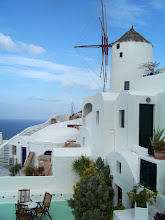
Thursday, December 27, 2007
Tibetan Mandala

Wednesday, December 19, 2007
Blade Runner 25 Years
Blade Runner Final Cut trailer
Libeskind in Cincinnati

Tuesday, December 18, 2007
Michel Gondry's trick
If you can't figure it out, like me, here's the solution -
Saturday, December 15, 2007
The World of Andy Goldsworthy




Both the creation and destruction of his works happen so naturally, that you enjoy the whole process just like appreciating the peaking and fading of fall foliages. The death/birth dichotomy is a repetitive theme of his work, such as his interpretation of a black hole. This also explains his obsession with rivers and tides, the beauty within natural cycles. It’s a deeper understanding of the essence of nature and the essence of life.
The movie is quite a success. With frequent use of long takes and track shots, it brings us so close to Andy’s works and mind. It’s a mesmerizing experience, both cinematic and artistic.
Tuesday, December 11, 2007
A Boy with A Balloon

The Red Balloon is a French film telling a simple and magical story between a little boy and a red balloon he picks up one day. With no dialogue, we enter a visual world by following the boy through many streets of old Paris. We cannot hold our eyes back from the delightfully bright red balloon against the grey cityscape. Hope and warmth rises as all the balloons in Paris fly to the boy after his red balloon is killed by naughty boys.

Little Fugitive doesn’t look like an American movie, for its noticeable European artistic and subtle style. This time, we follow a little boy Joey to Coney Island, the closest fantasy land for New Yorkers. Interesting enough, Little Fugitive has a scene where Joey is holding a balloon in his hand. Thus these two films are linked by a common image: a little boy with a balloon.
Monday, December 10, 2007
Inland Empire

Happy Birthday, DEGINE!
 DEGINE is 1 year old today! There were 114 posts in the past year, not too bad, right? Knowing I'm not a very persistent person, keeping this blog is a real challenge. I noticed my categories keep expanding, from the original design field to almost anything that interests me. I like this transition since the world of design is a living and integrated sphere. So don't be surprised to find DEGINE grow into a hybrid monster in the future!
DEGINE is 1 year old today! There were 114 posts in the past year, not too bad, right? Knowing I'm not a very persistent person, keeping this blog is a real challenge. I noticed my categories keep expanding, from the original design field to almost anything that interests me. I like this transition since the world of design is a living and integrated sphere. So don't be surprised to find DEGINE grow into a hybrid monster in the future!
Friday, December 7, 2007
Arup Lighting

Galleria Department Store, UN Studio



Prada, H & de M

Webb Bridge, Denton Corker Marshall and Robert Owen
Wednesday, December 5, 2007
The One-Man Band

Orson Welles: The One-Man Band is an awesome documentary on Orson Welles’ unfinished projects during the last 20 years of his life. Surprisingly, the opening scene shows Welles performing as a professional magician. Later I understood the purpose of this: it’s not merely a demonstration of his versatileness, although we know he did have great talent in so many things: directing, acting, writing, editing, producing…Metaphorically, his fascination with magic also refers to his self image, as pointed out in the film that one of Orson Welles’s most famous tricks is his silhouette: a disguise, an abstraction of his self, or simply a game.
Renowned for his early career fame such as his 1938 radio broadcast of The War of the Worlds and films like Citizen Kane, Welles is taken by the critics as a burned-out genius who had done nothing during his late years. However, this film shows us some “behind the scene” of Welles’s unknown life and works, offering more understanding to the tricks he played. Oja Kodar, his long-time companion, also the leading actress in his independent film projects, takes us through these precious footages and sketches by Welles. I’m so impressed with the amount of works he had accomplished during those years, although they never got finished due to mostly financial problems. He worked so independently that he did scripting, shooting, acting, set design and editing all by himself.

The One-Man Band is a short movie in which he played several different characters. As he joked: I, myself, have always been the “one-man band”. Despite constant financial problems and rejections from mainstream, he never gave up his dream. He used money from acting and commercials to fund his own projects, one after another. Like he said to the audience when receiving Lifetime Achievement Award from AFI in 1975, “I use my own work to subsidize my work. In other words, I’m crazy. But not crazy enough to pretend to be free.”
